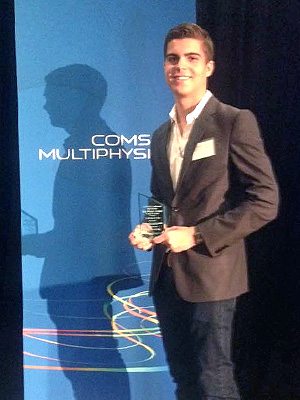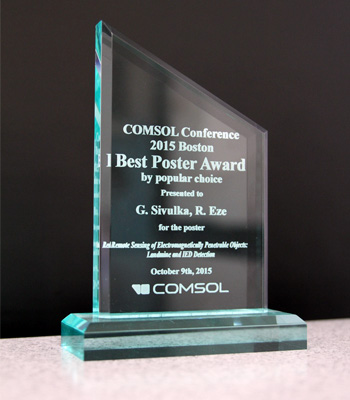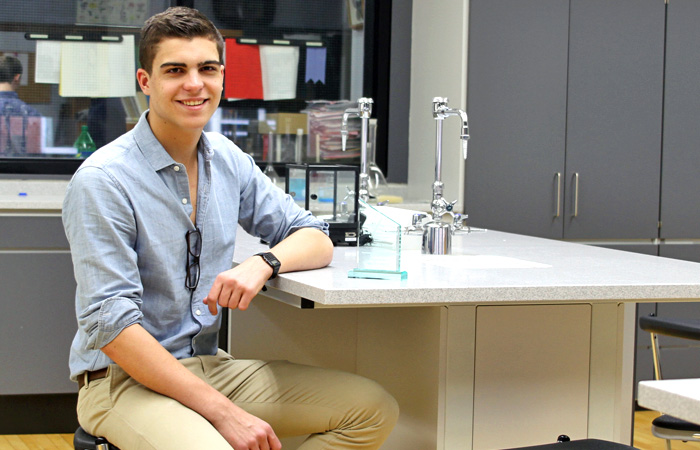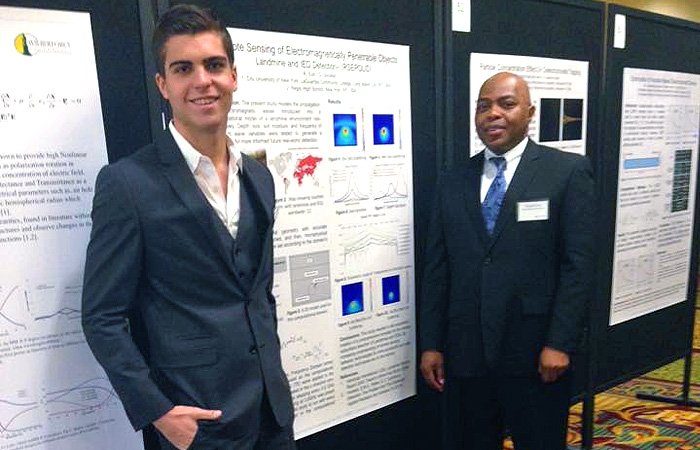Passion for Data Science Fuels One Student's Hunger to Change World
Above: George Sivulka '16 with his 2015 COMSOL Multiphysics Conference award for his presentation titled "Remote Sensing of Electromagnetically Penetrable Objects: Landmine and IED Detection".
George Sivulka 16's idea of a fun weekend is not that of a typical teenager. Then again, the Englewood Cliffs, NJ native is no typical teenager.
When not performing computation or data-based research at a Columbia University or City University of New York laboratory, Sivulka spends most of his free time on his laptop coding. It is a passion he developed between his sophomore and junior years at Regis when he was selected to participate in an elite program at NASA's Goddard Institute for Space Studies. During that time, he was paired with Dr. Reginald Eze, a faculty member and researcher at LaGuardia Community College. Their research focused on discovering a way to better detect land mines and understand scattering results from data simulations. With a hunger to do something that could have a positive impact on the world, Sivulka was hooked.
 "We ran models of land mine environments and varied parameters such as size, type, composition, depth underground, shape, and so on," said Sivulka.
"We ran models of land mine environments and varied parameters such as size, type, composition, depth underground, shape, and so on," said Sivulka.
"Our simulations created a template of mine scattering results for comparison to real world Ground Penetrating Radar (GPR) data, so that when people go out and use GPRs to detect land mines, they can better understand not only the location but also the characteristics of the mine to run a successful demining procedure."
When he began his internship before his junior year, Sivulka only knew basic concepts of physics and had no formal background knowledge in programming. In fact, he had yet to step foot in a pre-calculus or physics classroom, thus requiring a lot of on-the-job training. It turns out the Regis senior was up for the task.
(Pictured: George Sivulka '16 with the award for Best Poster at the 2015 COMSOL Conference in Boston, MA)
Spending hours upon hours in the lab, Sivulka taught himself how to code in a MATLAB, learned vector calculus, and familiarized himself with a considerable amount of physics.
"It was a huge learning experience. Now as a senior I'm taking Advanced Physics, Accelerated Calculus, and Java Programming and I'm understanding a lot more of the theory behind what I learned on the job."
Sivulka was so passionate about his research, that he chose to continue working on it this past summer by adapting results from the last year into a paper and running simulations to find new results.
"My parents weren't too happy that I turned down a paid internship," joked Sivulka.
"But I was doing what I wanted to do and doing something that I felt was meaningful. That was really important to me."
Recently Sivulka's dedication paid off. At the 2015 COMSOL Multiphysics Conference held this past October, he and Dr. Eze were presented with the Best Poster award for their presentation titled, "Remote Sensing of Electromagnetically Penetrable Objects: Landmine and IED Detection". Their poster was selected from a variety of projects submitted from professional attendees representing institutions from around the world. The award was chosen by popular vote among the scientists and researchers in attendance.
 The poster recapped Sivulka's investigations to detect buried environmental hazards, such as landmines and improvised explosive devices (IEDs). It demonstrated how—using COMSOL Multiphysics software—he generated a template for subsurface detection of buried hazardous objects. The results illustrated the ability of finite element modeling with COMSOL Multiphysics to efficiently and accurately simulate real-world sensing situations. Sivulka and Eze's research was published in the conference journal.
The poster recapped Sivulka's investigations to detect buried environmental hazards, such as landmines and improvised explosive devices (IEDs). It demonstrated how—using COMSOL Multiphysics software—he generated a template for subsurface detection of buried hazardous objects. The results illustrated the ability of finite element modeling with COMSOL Multiphysics to efficiently and accurately simulate real-world sensing situations. Sivulka and Eze's research was published in the conference journal.
With the simulation results, Sivulka hopes to advance knowledge and understanding of remote sensing techniques for future improvements.
"When you find something new—when you see the results for the first time—you're the only person in the world that has that knowledge, and you feel like you've contributed something, like you've accomplished something," said Sivulka.
(Pictured: The 2015 COMSOL Multiphysics Conference award for Best Poster)
"I feel like the possibility that I could do what I love to help others… that realization has been hugely transformative and it has affected my understanding of my own potential and how I want to give back to the world. I think that's part of what Regis has instilled in me."
Between college essays and applications, Sivulka continued to build simulations and explore his understanding of coding. His dedication has continued to pay off, as just last week he learned of his acceptance into Stanford, his top choice for college. He hopes to study both science and technology when he begins his college career in the fall of 2016.
Until then, Sivulka remains strikingly focused on his research projects.
"I'll always prefer doing something productive over going to parties," added Sivulka, whose facial expression immediately hinted at remorse for uttering something that sounded so anti-teenager.
"Though I do love to go to parties," he added, with a smile for reassurance.
Above: George Sivulka '16 (left) and Dr. Reginald Eze (professor, City University of New York LaGuardia Community College) at the 2015 COMSOL Conference in October.
Read more Regis news

